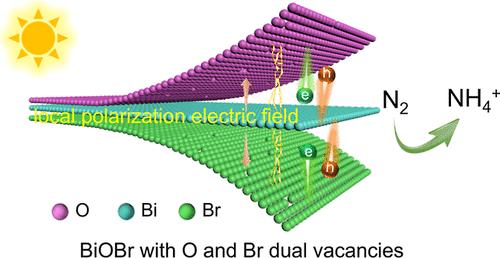氧和溴空位协同诱导局部极化电场增强生物obr光催化固氮作用
IF 13.1
1区 化学
Q1 CHEMISTRY, PHYSICAL
引用次数: 0
摘要
光生电荷分离效率低,严重阻碍了光催化氮(N2)固定。缺陷引起的局部极化电场(LPEF)可以促进电荷分离,但纯相中不同类型缺陷的协同效应和相关机制尚不清楚。在本研究中,无缺陷氧化溴化铋(BiOBr;成功合成了单空位(BOB- vbr和BOB- vo)和双空位(BOB- vbro)类似物,并对这些特定空位的存在进行了全面表征。在液固两相体系中,双空位BOB- vbro光催化NH3生成速率最高,为266 μmol g-1 h-1,分别是BOB、BOB- vbr和BOB- vo的6.1、1.5和1.4倍。在气-液-固三相体系中,BOB-VBrO的NH3生成能力达到了令人印象深刻的978 μmol g-1 h-1。光电化学测试结果表明,BOB- vbro具有最高的光转换效率,其次是BOB- vo、BOB- vbr和BOB。BOB- vbro的内部电场相对强度也非常高,分别是BOB- vo、BOB- vbr和BOB的1.8倍、2.4倍和3.9倍。Br和O空位协同诱导了[O]/[Br]和[Bi]层之间的LPEF。原位辐照x射线光电子能谱表明,低聚物的O和Br空位可以协同增强LPEF,从而促进光生电子从O/Br向Bi的转移。此外,还验证了BOB-VBrO光催化固氮生产植物生长所需液氮肥料的实际可行性,揭示了其在农业生产中的潜在应用前景。本文章由计算机程序翻译,如有差异,请以英文原文为准。

Oxygen and Bromine Vacancies Synergistically Induce Local Polarization Electric Field for Enhanced Photocatalytic Nitrogen Fixation on BiOBr
The low efficiency of photogenerated charge separation significantly hinders the photocatalytic nitrogen (N2) fixation. Local polarization electric field (LPEF) induced by defects has been known to enhance charge separation, yet the synergistic effects and mechanisms related to different types of defects in pure phases remain poorly understood. In this study, defect-free bismuth oxybromide (BiOBr; BOB), together with single vacancy (BOB-VBr and BOB-VO) and dual vacancy (BOB-VBrO) analogues, were successfully synthesized, and the presence of these specific vacancies was comprehensively characterized. Notably, the dual vacancy BOB-VBrO exhibited the highest photocatalytic NH3 generation rate of 266 μmol g–1 h–1 in a liquid–solid biphasic system, which was 6.1, 1.5, and 1.4 times higher than those of BOB, BOB-VBr, and BOB-VO, respectively. Furthermore, the NH3 generation capacity of BOB-VBrO reached an impressive rate of 978 μmol g–1 h–1 in a gas–liquid–solid triphasic system. Photoelectrochemical tests revealed that BOB-VBrO demonstrated the highest light conversion efficiency, followed by BOB-VO, BOB-VBr, and BOB. The relative intensity of the internal electric field in BOB-VBrO was also significantly high, being 1.8, 2.4, and 3.9 times greater than those of BOB-VO, BOB-VBr, and BOB, respectively. The Br and O vacancies synergistically induced LPEF between the [O]/[Br] and [Bi] layers. In situ irradiation X-ray photoelectron spectroscopy indicated that O and Br vacancies of the oligomers could synergistically enhance the LPEF, thereby facilitating the transfer of photogenerated electrons from O/Br to Bi. Additionally, the practical feasibility of BOB-VBrO in photocatalytic N2 fixation was validated to produce liquid nitrogenous fertilizer for plant growth, revealing its potential application in agricultural production.
求助全文
通过发布文献求助,成功后即可免费获取论文全文。
去求助
来源期刊

ACS Catalysis
CHEMISTRY, PHYSICAL-
CiteScore
20.80
自引率
6.20%
发文量
1253
审稿时长
1.5 months
期刊介绍:
ACS Catalysis is an esteemed journal that publishes original research in the fields of heterogeneous catalysis, molecular catalysis, and biocatalysis. It offers broad coverage across diverse areas such as life sciences, organometallics and synthesis, photochemistry and electrochemistry, drug discovery and synthesis, materials science, environmental protection, polymer discovery and synthesis, and energy and fuels.
The scope of the journal is to showcase innovative work in various aspects of catalysis. This includes new reactions and novel synthetic approaches utilizing known catalysts, the discovery or modification of new catalysts, elucidation of catalytic mechanisms through cutting-edge investigations, practical enhancements of existing processes, as well as conceptual advances in the field. Contributions to ACS Catalysis can encompass both experimental and theoretical research focused on catalytic molecules, macromolecules, and materials that exhibit catalytic turnover.
 求助内容:
求助内容: 应助结果提醒方式:
应助结果提醒方式:


